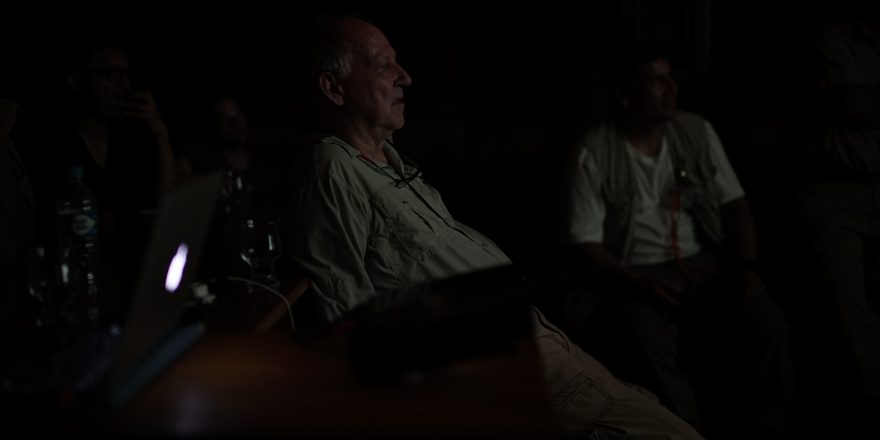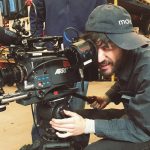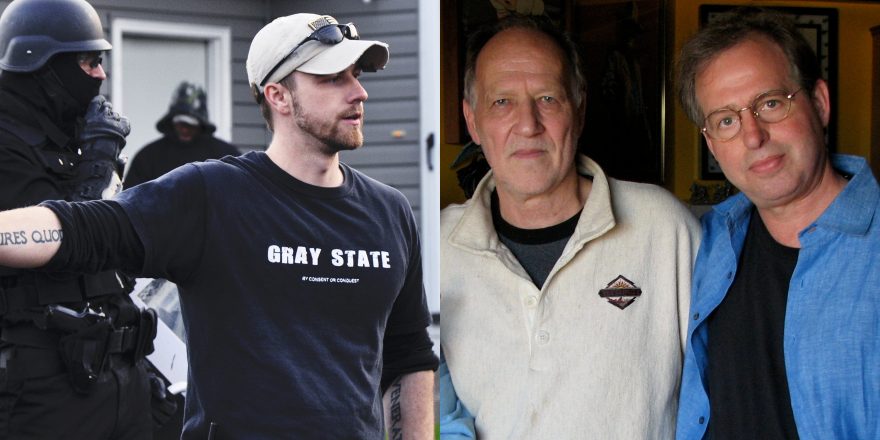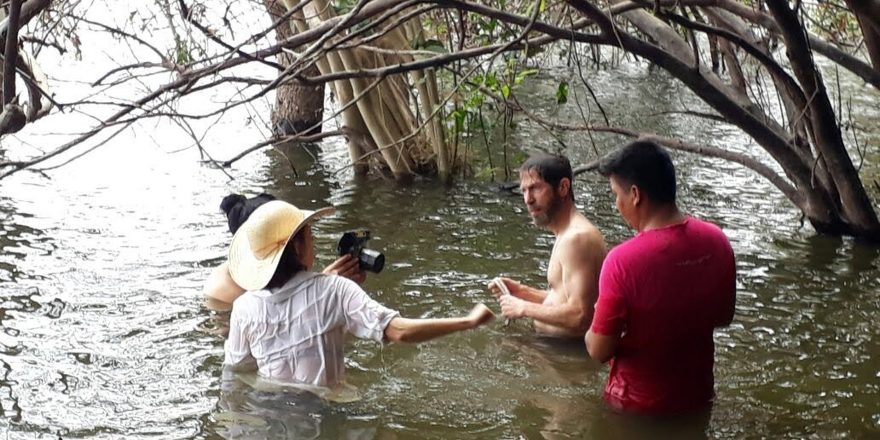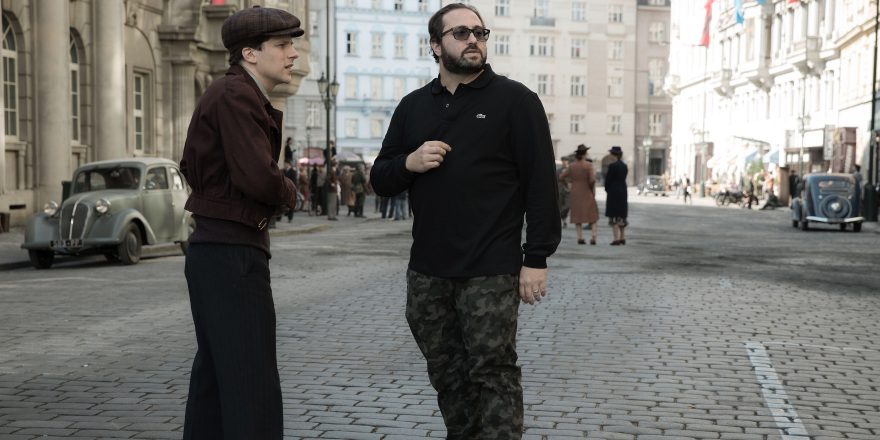“Our culture — the poets will hold it together.”
There were 48 of us. None of us knew each other, but in the airports we could somehow recognize each other. It must’ve just been that look in our eyes; we were all heading down to live for two weeks with Werner Herzog in the Peruvian Amazon, where each of us would make films, and none of us knew what to expect …
The first night in camp after a 24-hour itinerary for me: Los Angeles to Lima, Lima to Puerto Maldonado, a bus to the docks and then a 40-minute boat ride to Inkaterra, a remote eco-lodge situated near the banks of the Madre de Dios stretch of the Amazon River. The place was founded in 1975 by José Koechlin von Stein, who produced both Aguirre, the Wrath of God and Fitzcarraldo and was the reason Herzog came to Peruvian jungle in the first place. By now Herzog was long legendary here, as even on the plane the announcement came blaring over the loudspeaker as we arrived: “Werner Herzog has returned to Peru!”
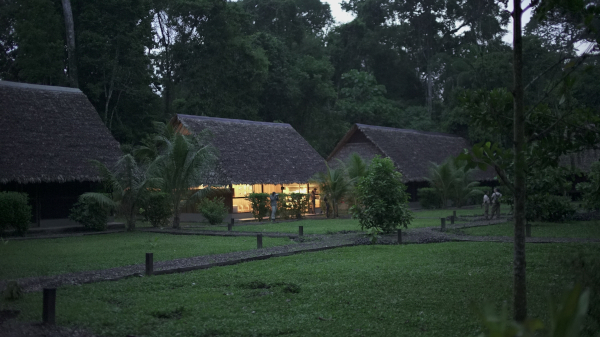
Large thatched roofed cabanas would house us all, divided into four-person rooms. Each bed equipped with a mosquito net, a necessary tool to ward off the jungle. After orienting ourselves to camp, we awaited Werner’s arrival in the commons area. When he came in the room, there was at first that dreaded sense of mythological beauty, for Werner himself is a myth; has spent his career building myth, not only around his stories but around himself. Very quickly, he seemed to want to diminish this, as he went around the room and shook all of our hands and exchanged introductions, admitting, “I’m terrible with names, but we’ll get it.”
He began by revealing the theme of the workshop, “Fever dreams in the jungle,” to which we all delighted — but none more so than Werner himself. He had this perverse smile on his face, as if it was the most exciting theme ever committed to language. You could see his childlike love of cinema already starting to radiate. We were to cast aside any preconceived ideas we had flown in with, and we would begin scouting locations for our films in the morning. We ate food, found conversation, and settled in …
Walking back to my room after dinner there was already a group of filmmakers observing a giant snail, the size of a watermelon, crossing the dirt path. Cameras, phones and lights were out, filmmakers were flocking together, experimenting already. (This snail ended up as the star of Sebastian Lopez Borda’s film Tunche Fever). The camaraderie — and the competition — was on.
Up until now, filmmaking workshops weren’t really on my radar, and I always naively considered them as a form of mental masturbation. Equally strange was the idea of Werner Herzog — someone who appears to largely share this belief — holding his own workshop. But it was this contrast that drew me in deeper. What does an anti-workshop workshop look like? I was starting to see.
“I’d rather spend an evening with the extras than an evening with the stars.”
In the morning, Herzog took his place among one of three boats – the same one as me – to travel to Lago Sandoval, a 45-minute ride. He sat amongst us and you could tell we were all still a bit dreamy in his presence. It was the suave British documentarian Rupert Clague, with the confidence of a buck, who first struck up conversation with the man. He just went right in for it. I’ll always admire him for that.
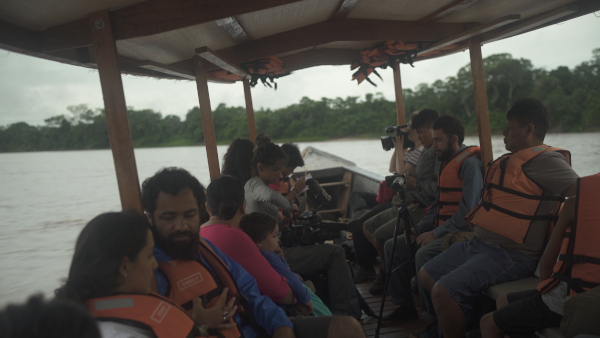
Seats shuffled a bit and I found myself next to the Werner for the first time. I hadn’t prepared anything to say, but I followed Rupert’s lead and went with a question: “Werner.” He turned his head. “What ever happened to Marc Anthony? From The White Diamond?” —
— Four months prior to this moment, my friend Jake King sat me down on his couch and said: “You’re gonna watch this movie.” It was The White Diamond, a film about airship engineer Graham Dorrington’s second-chance expedition to float above the Guyana jungle in his flying machine (a dangerous proposition considering his first mission had resulted in the death of his cameraman). I often think about the movie and how Herzog is able to find people on the periphery of life, to coax them out, to put them where they need to be. And now he had found us … —
“Oh, yes, of course. He found his mother in Spain after the film and reunited with her.”
“So films can change the world.” I said, impurely.
No response from Herzog. Not impressed.
By the end of the trip, we would all seem as close as family, but for now things were still fresh. It’s an amazing feeling, being new to something. It’s a rush, a feeling worth remembering; protecting.
—-//—-
Up ahead, people in one of the other boats noticed something floating in the water. Upon inspection, it was the body of a man, lifeless in the water. Speculation was that he had become drunk, fallen into the water and drowned. But we all had our own versions of the story swimming in our heads. The myth-making had begun. Welcome to the jungle.
“We will not launch with our weapons of war.” This meant no cameras allowed on our location scout. Imagine unloading 48 filmmakers, equipped with cameras, into a native subsistence community? There would’ve been bloodshed. As we docked our boats on the shores of Palma Real, the filmmaking-as-war metaphors were not lost on me.
As we entered the native community, the chief – headdress and all – met us at the entrance. He explained the importance of the Brazil nut to their survival, and showed us how a falling husk can have enough weight to kill a man, if struck in the head. As we shuffled past the first structure in the town, a couple of young boys held sticks as if they were AK-47s, and complete with mouth-made sound effects, mowed us all down as we marched slowly into the village. The trope of the television cowboy has reached even this far. And strangely, as we pass the thatched-roof huts of the village, some were adorned with DirectTV satellite dishes. “There’s no escape,” I thought. Not anymore.
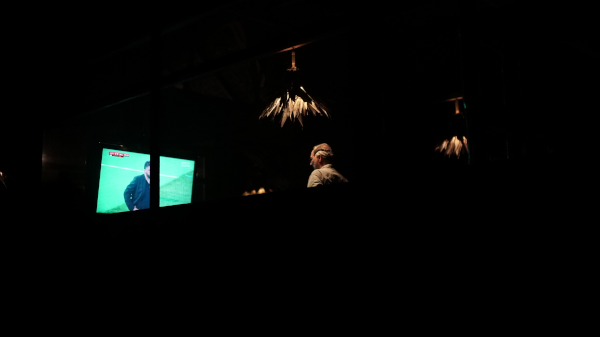
Later that day, we took a hiatus so Werner could watch Bayern Munich play in the Champions League. Back at camp, the signal was piped in from god-knows-where, we gathered around a screen, drank beer and watched the soccer game. The dissonance of this moment was jarring, to say the least, but somehow fitting. And it would ultimately change the trajectory of my life.
“It’s not bad to take revenge. To do it viciously and with great enthusiasm. But don’t get caught.”
The city of Puerto Maldonado, with a population of about 85,000, is nestled alongside the breathtaking stretch of Amazon River. Floods come through every few years when the river rises and wipes out the structures near the shore, but the Peruvians don’t seem to mind, they just rebuild.
The first location I visited was the Fermin Fitzcarrald School, where I set out to find a young actor. There were several of us invading the school on a casting mission, but the first thing I did when I got there, instinctually, was to drop my backpack and start playing basketball with the kids. I must say, at a 90 percent airball rate, basketball is not Peru’s game, but even in the humid heat I was having fun. After a few minutes of playing, I heard a distant clapping and looked to my right and to see Werner — who I didn’t even know was at the school — with a fat grin on his face, approaching me. “Yes! That’s how you do it!”
At the school, I ended up making a film about a 10-year-old girl who came to me in tears, telling me her stories of domestic abuse, sadly a common story. I spent a few days walking around the schoolyard with her as she told her story. I had a translator stationed at the school to help me communicate. Each day I came by, we would shoot, I would pay her some money, and she would return to class. After the second day, her tears had run dry, her story was told, but she wanted to continue. I repeated the same questions, but got different answers. I started to get the feeling I was being swindled.
I thought, “What am I doing? This isn’t it. This isn’t the film. There’s another film out there.” So I went back to the drawing board.
“Don’t come back until you’ve got something really wild. Let the pig loose!”

I was half asleep on the morning boat to town, but I couldn’t shake this dissonance between the jungle and this ubiquitous obsession for soccer culture. I thought, “What if a man was going about his day, narrating his own obituary, but the obituary for the life he wished he had — the life of soccer stardom?” I fought my tired eyes and the gentle rock of the boat to put this idea to paper. By the time the boat arrived at the town, I had a couple dense pages of inspired thoughts and was ready to meet the actor I had signed up to be in the film.
When I got to the town square, we were out of translators. With only eight translators for 48 filmmakers across disparate locations, this was an inevitable issue. One of our chaperons, Nuria, gave me a list of translators and I hired a random one. He arrived before the actor, and we chatted briefly. I showed him my two-page script. “Nice guy,” I thought.
The next day, my translator and I met again in the park, chit-chatted a little bit and took a tuk tuk to the actor’s house, where he said we could film. We spent 30 minutes shooting the opening line of dialogue, a scene were the protagonist gets on his motorcycle and attempts to ride it out of his apartment building. It wasn’t going well. He couldn’t remember the dialogue, clearly having not studied it the night before, and it wasn’t flowing. In a moment of divine decisiveness, I had the solution. I thanked the actor for his time and told him we would break until tomorrow.
On the way back to the town square, I asked my translator a good place to get some cigarettes. We found a little hole in the wall, bought some cold Inca Kolas, and that’s when I laid it on him. I said, “Chino, here’s the thing: You’re the guy. You understand what I’m trying to do. I want you to do the movie.” After some humble reticence about the prospect of taking another man’s job, he accepted, and we clinked bottles.
That night, Chino showed me another side of the city. We rendezvoused with Brett Pedersen, a Canadian filmmaker from the program, and took a cab to a remote enclave where there’s a yoga sanctuary. There was organic cooking, exotic Maca beverages and a gathering of locals, travelers and Dutch scientists stationed at a nearby animal sanctuary. What strange dream were we in now?
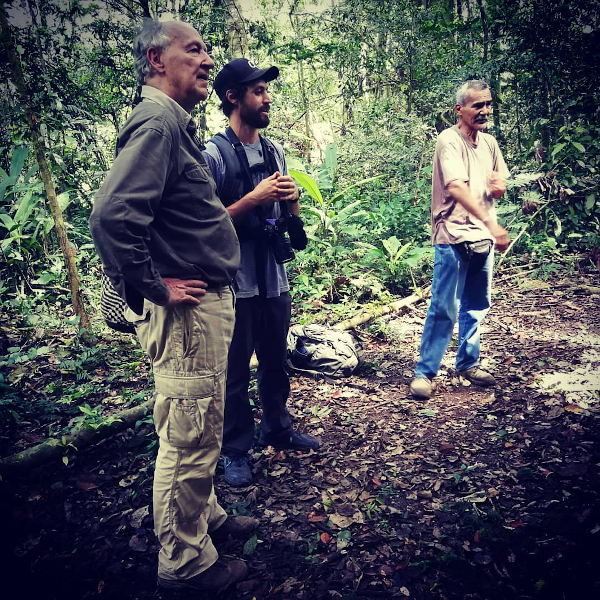
After a few drinks, Chino started to display his knowledge of famous Peruvian soccer announcers and the many slang terms used to describe a soccer ball in Peru: “La Rondita,” the round one; “El Numero Cinco,” number five, referring to regulation sizing. A “huacha” is a nutmeg, putting the ball through the opponent’s legs. A “huachita” is a very small or fine huacha. I was learning a lot, mostly that I had found the exact right actor.
Later that night, I returned to my hostel. I was buzzing with ideas and my hostel-mates were coughing, but there were only a few days left, and I needed some sleep for the shoot in the morning.
“Some images demand to be seen. Real great footage has a mysterious quality, it always fits together. It always somehow connects.”
It’s funny how when something is important, all the details matter to you. I can remember almost every second of that day, the way it unfolded. The way we shot and swayed through the streets. We started brisk and early at 5 a.m., immediately on the right foot: Chino had the script memorized, and yet was bringing to it all the nuances we had spoken of the night before. We were jamming like two musicians, listening to each other and working it out. Call and response. It was joyful. We shot all our scenes in the city in three hours, just in time to catch the last boat back to Inkaterra, to finish the shooting in the jungle.
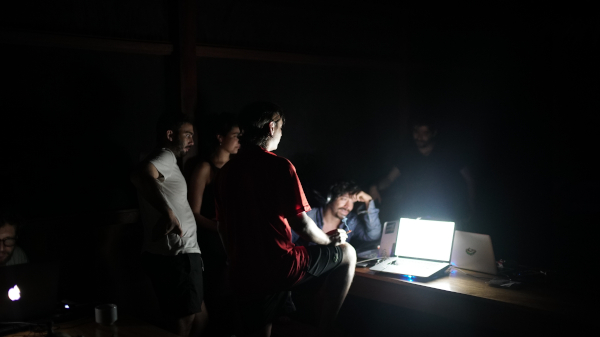
Editing a movie in the jungle is its own kind of sport. We only had access to electricity during peak hours, but many of us would stay up into the wee hours of the night, editing until our batteries died. It’s a strange experience to edit knowing you have limited electricity. It adds an immediacy to your decision making. You have to use your instincts. Those last few days before the end of the workshop, we all stayed up, shared stories, shared edits, shared hopes and fever dreams late into the night …
It was during those nights that I really realized that I had fallen in love with this place, and I knew I wanted to continue the tradition of adventurous filmmaking in the jungle.
“We are not accountants.”
It was time to show our completed films. I woke early and started the final export of the film to my thumb drive. I smoked a cigarette outside and watched the fog roll over the trees. After breakfast, we all hiked out to one of Inkaterra’s satellite stations to set up the theater. It had only been 10 days, but each of us had bled and sweated and toiled over these films. We were all so curious to see each other’s work, 48 unique voices to a shared experience. It was our secret jungle film festival, Werner said. A projector screen and a PA system.
I reached into my pocket and realized: I had forgotten my thumb drive. Instantly, I shot up and started running. Round trip, it’s a 15-minute walk to the field station, so I had to run fast. As I sprinted down the jungle path, the adrenaline kicked in. My breath, fast and guttural, started forming its own rhythm, something ancient and primal. In this moment, running full speed, I entered a trance, a state of rhythm with my breath and step. In the jungle, awareness of your surroundings is heightened. You have to move gently, in agreement with the jungle. Now I was completely surrendering to it.
As I ran, my vision blurred, my awareness suddenly peaked and I stopped short — a thick yellow snake facing me on the path. With no time to spare (my screening was on the line!), acting on instinct alone, I delivered a deep, threatening, guttural hiss at the snake. To my amazement, it worked. The snake gave me one last look before sliding off the path into the jungle. (Later, I would learn that this was the feared Shushúpe, the bushmaster, the most venomous snake in the Western Hemisphere. If bitten, you have only seven minutes to live.)
Seven minutes after leaving, I was back, trying to catch my breath as I handed in the thumb drive to be played, just in time. And before long, there was Herzog, looking me in the eye, about to review my film in front of my peers. I was still catching my breath.
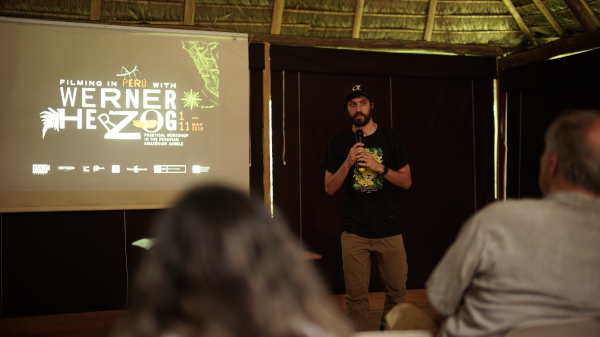
“This way you let the character leave the frame and re-enter, it’s a gimmick — well, you could say it’s a gimmick, but actually, it’s not.” He turned to me. “You know exactly what you are doing,” he said.
—-//—-
As filmmakers, we often go through phases of doubt. What are we doing with our lives, making films? It’s such a struggle to get anything made, and a miracle when they turn out good. Why do we do it? However, there in our makeshift theater in the middle of the jungle, we all had the most potent reminder. We pushed each other out of our comfort zones, we were willing to pivot when we recognized that things were wrong, and we were willing to meet the world halfway, to greet it with a camera. “Go where the stories are,” he says. And if that doesn’t work? Use your imagination.
During this screening, I felt a strange metaphysical torch being passed, not to me, but to the whole room, to an entire generation of filmmakers, who would absorb his energy and put it into their own lives, their own films, and thereby into the world. Werner shared himself with us openly and freely, as he has shared his life with the world through cinema. A truly generous spirit. A lover of humanity. His icy German personality is functional: It keeps the joy in; it is the thorn that protects the rose. Underneath it all, he’s maintained a childlike glee in the perverse and the sublime, and in all things cinema.
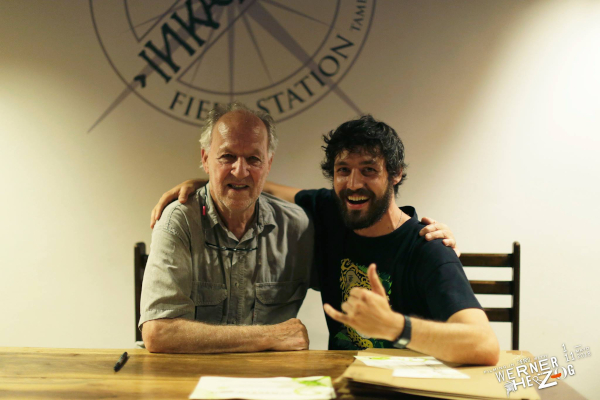
I’ll never forget the rain washing off our danced-out bodies at the closing celebration. Two motionless boats floating in the night, alive with the sound of 20 filmmakers singing pop songs. The giant grasshoppers interrupting our editing sessions. Smoking cigarettes with Werner, while he modestly admitted that his wife wouldn’t approve. And I’ll never forget the way I felt when he said it to us at the end, a twinkle in his eye: “It’s your world now. Good luck.”
All at once the feeling rushed back to me: Yes, this is exactly what I am supposed to be doing with my life.
—-//—-
(Organized by founders Estephania Bonnett Alonso and Liliana Diaz, the 2018 Black Factory Cinema workshop was led by Werner Herzog, who took a group of 48 filmmakers from 35 countries on a filmmaking expedition in remote Amazon jungle. Estephania and Liliana won the 2018 Werner Herzog Film Award, an endowment for those providing courage, vision and innovation to the art of cinema. My short film Del Arco Vacío finished first out of the program, went on to have a special Werner Herzog Foundation screening in Munich, and provided the inspiration for my next film, Snake Oil Song, now in pre-production.)



